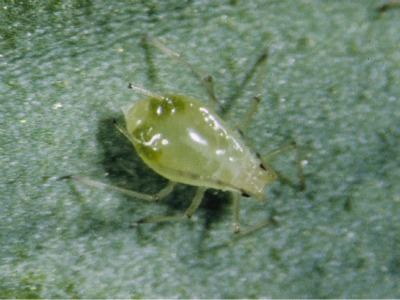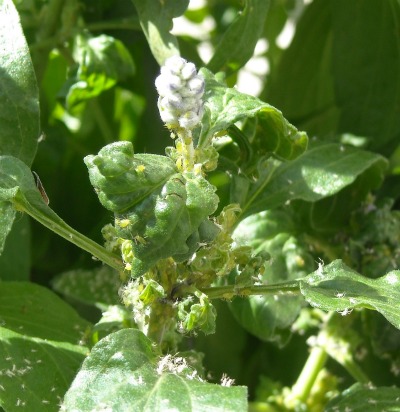
Features
Business
Labour
Foxglove aphid and spring floral crops
March 4, 2011 By Sarah Jandricic and John Sanderson (Cornell University Ithaca N.Y.)
NEWS HIGHLIGHT
Foxglove aphid and spring floral crops
Picture it: it’s a beautiful spring day, and you’re
walking through your early bedding crops. The sun is shining, it’s a
breezy day out, and you’re thinking, “thank goodness I don’t
have to worry about insect pest problems yet! It’s far too cold. After
all, bugs like it hot.”
March 4, 2011 – Picture it: it’s a beautiful spring day, and you’re walking through your early bedding crops. The sun is shining, it’s a breezy 60˚F (15˚C) out, and you’re thinking, “thank goodness I don’t have to worry about insect pest problems yet! It’s far too cold. After all, bugs like it hot.”
And then you see it.
Cast skins. Honeydew. Distorted leaves. Hand trembling, you turn over a leaf and see … APHIDS!
Our research has revealed that one particular aphid does enjoy cool weather after all, and that’s the foxglove aphid. According to our 2004 survey of aphids in floriculture greenhouses in the Northeastern U.S., the foxglove aphid, which used to be considered more of an “occasional” pest, is now the number two aphid pest problem (behind green peach aphid).
And, according to our Canadian friends, foxglove aphid has become a major cause for concern in Ontario greenhouses as well.
This pest can infest an impressive variety of ornamental plants (both herbaceous and woody), and has been reported on over 95 different plant species. Foxglove aphid can infest just about every ornamental that is attacked by green peach or melon aphid, plus a few more. Some of their more favorite ornamentals include: pansy, blue salvia, scarlet sage, pentas, million bells, geranium, garden chrysanthemums and potted mums, lilies, alstroemeria and even poinsettia.
Here’s what you need to know about this pest for the spring growing season, when this aphid is at its peak:
IDENTIFICATION
Foxglove aphids are larger in size than green peach or melon aphids, being approximately 1.8 to 3 mm long. They are pale green to yellow in colour, and have somewhat of a “shiny” appearance compared to other aphids. One of their distinguishing features is the presence of two large, dark-green spots near the tip of their abdomen at the base of their cornicles – long tubes that look like “exhaust pipes” (Figure 1). These spots can easily be seen using a hand lens, especially on adults. They also have black banding on their legs and antennae, which is not present on the other common greenhouse aphid pests.
DAMAGE
Like most aphids, foxglove aphids cause plant wilting, yellowing of leaves, and also leave behind unsightly white-coloured skins that have been shed as they grow. They also excrete large amounts of honeydew: a sticky, sugary substance that can encourage the growth of dark grayish sooty moulds on plants.
 |
| Figure 1. Foxglove aphid. Photo courtesy of Dan Gilrein (Cornell Cooperative Extension of Suffolk Co., N.Y.). |
But unlike other aphids, foxglove aphid also has a toxic saliva, which is injected into the plant as it feeds. The toxin can lead to curled and twisted leaves (Figure 2), spots of dead leaf tissue, and can even cause early leaf-drop. Because of this, foxglove aphid may cause irreversible cosmetic damage to ornamental plants at much lower numbers than that seen with other types of aphids.
FOXGLOVE APHID AND TEMPERATURE
Like typical aphids, foxglove aphid adult females don’t need to find mates to reproduce (there are no males under greenhouse conditions). They don’t lay eggs but instead give birth to live young, and their daughters are born pregnant – they already have their own daughters developing inside them as soon as they’re born.
Aphids generally have more offspring and develop faster at warmer temperatures, which is one of the reasons why aphids like green peach aphid and melon aphid are usually more of a problem in the summer months.
But, according to our research, foxglove aphid bucks the trend and actually has more babies at 50-60˚F (10-15˚C) than at 77˚F (25 °C): almost twice as many in fact. Foxglove aphid also develops faster than either green peach or melon aphid at 60˚F (15 ˚C). This means that even though other pest problems are stalled or slow-growing at cooler temperatures during spring production, foxglove aphid just keeps on truckin’.
One reason we may be seeing problems with this aphid recently is because we’re growing our crops at cooler temperatures nowadays to save money on heating costs, and this may set up the optimal environment for foxglove aphid.
The good news in all of this is that foxglove aphid doesn’t do well at really warm temperatures. These aphids can barely grow and can’t reproduce at constant temperatures of 86˚F (30˚C) or above, which explains why this pest is generally not a problem in the summer growing months, and why we’ve heard anecdotal reports that this aphid is less common in floriculture operations in warmer states such as Florida and Texas.
CONTROL MEASURES
Many growers have probably already encountered insecticide resistance issues when it comes to controlling the green peach aphid at one time or another. That’s because various strains of green peach aphid are resistant to several insecticides to various degrees (it’s actually considered the most insecticide resistant pest in the world!).
The good news with foxglove aphid is that, because it is such a “new” pest, it hasn’t had the chance to develop serious resistance to pesticides yet (the key word here being “yet”). So, if you do choose to turn to chemical controls, it’s important to use them sparingly and responsibly, lest we end up with another “green peach aphid” on our hands.
One of the things that can make controlling aphids with pesticides difficult is where they take up residence on the plant. When ornamental plants are in flower, foxglove aphids are often found on flower stems and on the flower petals themselves. Their presence on flower heads may mean that systemic insecticides such as imidacloprid won’t provide as much control as we’d like, since these chemicals aren’t able to translocate into petals.
On the flip side, if plants have not yet flowered, foxglove aphid can often be found at high densities on the underside of the lowest leaves on a plant. Although this locale would make adequate spray contact challenging, this is a situation where systemic insecticides would be ideal.
Several biological control agents are also available for this pest. Aphidius ervi, a parasitic wasp, can tackle larger aphids like foxglove aphid and potato aphid (remember: Aphidius colemani only works for smaller aphids, like green peach and melon aphid). Aphelinus abdominalis is another available parasitoid. The predatory midge Aphidoletes aphidomyza is a good aphid generalist, which means that it will attack a variety of aphid pests, including foxglove aphid and green peach aphid. However, it’s important to note that a higher rate of natural enemies (or more frequent releases) may be needed to achieve control in the spring, due to the colder conditions slowing down the development of the predator or parasitoid.
A good rule of thumb for biological control of aphids is that control can be better achieved if the natural enemies are released in the greenhouse preventatively, i.e., before scarce aphids actually become a problem.
 |
| Fig. 2: Foxglove aphids and their damage on blue salvia. Photo by J. Sanderson. |
One useful tool for this approach is the use of “banker plants.” Banker plants are an open rearing system that allows populations of natural enemies to build up in the greenhouse on plants other than the crop. For example, barley grass infested with the non-pestiferous bird cherry oat aphid gives the parasitoid Aphidius colemani alternate aphids to eat when numbers of green peach aphid are low. This not only allows natural enemy numbers to build up and protect the crop from incoming aphids, but the use of banker plants can also decrease the costs associated with biological control, as fewer releases of the natural enemies may be necessary.
In our research at Cornell, we are currently investigating the use of banker plants for supporting populations of Aphidoletes in the greenhouse, and winter wheat infested with the grain aphid Sitobion avenae is available for Aphidius ervi in Europe. However, it appears that a commercially available banker plant system for foxglove aphid in North America is still under development.
THE BOTTOM LINE
Foxglove aphid can be a problem at constant temperatures anywhere from 50-77°F (10-25 °C), and is most likely to be a problem in the springtime (from about February to May), so it’s important to be on the lookout and monitor your crop regularly. Look for tell-tale signs of aphids, such as cast skins on the leaves, glistening spots of honeydew, and curled, deformed leaves, and be sure to check the underside of leaves for unexpected guests. Caught quickly enough, there is hope that this extremely challenging pest can be controlled.
Sarah Jandricic is a PhD student in entomology at Cornell University who is currently working on the control of foxglove aphid in floriculture crops. John Sanderson is an associate professor at Cornell, specializing in the biology and management of greenhouse crop pests. Questions or comments about this article can be e-mailed to Jandricic at sej48@cornelledu.
Print this page